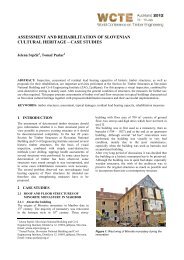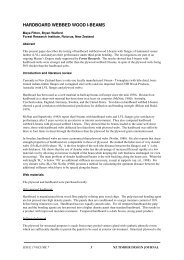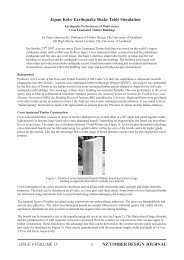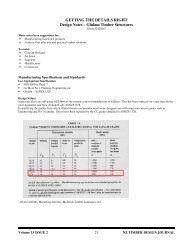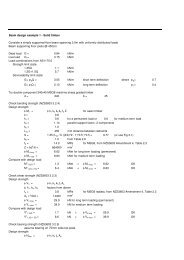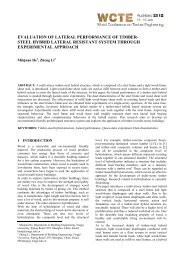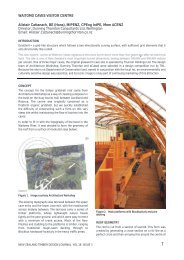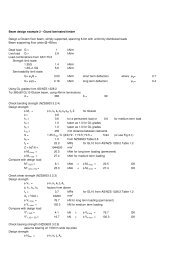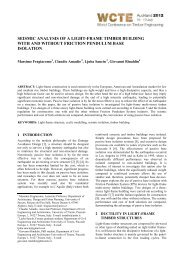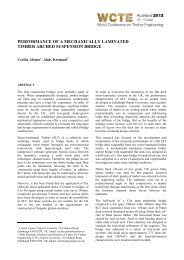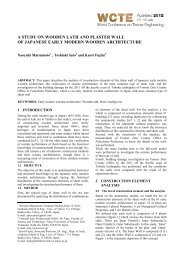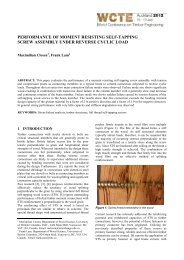Development of a design procedure for timber concrete composite ...
Development of a design procedure for timber concrete composite ...
Development of a design procedure for timber concrete composite ...
Create successful ePaper yourself
Turn your PDF publications into a flip-book with our unique Google optimized e-Paper software.
Assessment <strong>of</strong> the axial stress is derived from the<br />
flexural action. However, Equations 13a and 13b can be<br />
manipulated to identify the (corresponding) <strong>design</strong> axial<br />
<strong>for</strong>ce:<br />
N<br />
=σ<br />
where the allowable axial capacities are defined as:<br />
N<br />
Note: The characteristic tension strength must be<br />
reduced <strong>for</strong> <strong>timber</strong> member exceeding depth <strong>of</strong> 150 mm<br />
or modified in accordance with the manufacturer’s<br />
specification. 4<br />
5.2.2 Strength Requirements <strong>for</strong> Flexural Shear<br />
Strength<br />
In the absence <strong>of</strong> structural rein<strong>for</strong>cement in the<br />
<strong>concrete</strong> member, the flexural shear strength is<br />
provided by the <strong>timber</strong> member, there<strong>for</strong>e;<br />
Vd<br />
where <strong>for</strong> rectangular sections:<br />
' 2At<br />
Vd<br />
= φk1k4k6fs<br />
3<br />
Note: Some conditions, (<strong>for</strong> example use <strong>of</strong> a deep<br />
notch), may require reducing the shear plane area by<br />
using the net area <strong>of</strong> the (beam) cross-section.<br />
5.2.3 Strength Requirements <strong>for</strong> Bearing Strength<br />
The bearing strength is provided by the <strong>timber</strong> member,<br />
there<strong>for</strong>e;<br />
N<br />
in which:<br />
N<br />
A<br />
*<br />
c c,<br />
c c<br />
= φ f A<br />
'<br />
dc , c c<br />
N<br />
N<br />
= σ A<br />
(14a); (14b)<br />
*<br />
t t,<br />
t t<br />
= φkk k f A (15a); (15b)<br />
'<br />
dt , 1 4 6 t t<br />
*<br />
≥ V<br />
(16)<br />
d,<br />
p<br />
≥ N<br />
*<br />
p<br />
= φkkkk f A<br />
'<br />
d, p 1 4 6 7 p p<br />
(17)<br />
(18)<br />
(19)<br />
5.3 STRENGTH OF THE COMPOSITE ACTION<br />
(CONNECTION CAPACITY)<br />
The connection (or notch) transfers the shear <strong>for</strong>ce<br />
occurring between the members under flexure. The<br />
actual mechanics <strong>of</strong> this <strong>for</strong>ce transfer are relatively<br />
complex. However a prescriptive approach that defines<br />
connection capacities (based on empirical test data –<br />
refer to Figure 6) that ensures the <strong>design</strong> <strong>procedure</strong><br />
remains user-friendly, has been adopted <strong>for</strong> this<br />
document.<br />
5.3.1 Shear Strength <strong>of</strong> the Connection<br />
A global assessment <strong>of</strong> the connection strength is<br />
per<strong>for</strong>med. It includes the assessment <strong>of</strong> the strength <strong>of</strong><br />
the connection closest to the support, V max (shear <strong>for</strong>ce<br />
)<br />
N<br />
Characteristic stiffness Qk (kN)<br />
(k<br />
Q k<br />
th<br />
g<br />
n<br />
tre<br />
s<br />
tic<br />
ris<br />
te<br />
c<br />
ra<br />
a<br />
h<br />
C<br />
130<br />
120<br />
110<br />
100<br />
90<br />
80<br />
70<br />
60<br />
50<br />
40<br />
30<br />
20<br />
at the support), and the connection located at the<br />
quarter-span area, V L/4 (shear <strong>for</strong>ce at the quarter span).<br />
Note: Refer to Figure 6, <strong>for</strong> empirical strengths <strong>of</strong> the<br />
specified connections.<br />
where:<br />
and the effective shear <strong>for</strong>ce in the connection located<br />
near the support equals:<br />
and the effective shear <strong>for</strong>ce in the connection located at<br />
the ‘quarter’ span:<br />
5.3.2 Shear Strength <strong>of</strong> the Timber<br />
The shear strength <strong>of</strong> the <strong>timber</strong> – tangential shear<br />
action in the area located between the support and the<br />
first connection is assessed and checked as follows:<br />
where:<br />
25 50 75 100 125 150 175 200 225 250<br />
Beam width (mm)<br />
Trapezoidal<br />
Triangular<br />
Figure 6: Characteristic strength (Q k) <strong>of</strong> trapezoidal and triangular<br />
notches.<br />
Nd,<br />
j<br />
N<br />
≥ Q<br />
*<br />
= φk k k Q<br />
d, j 1 4 6<br />
γ<br />
cEAas<br />
c c c<br />
Q<br />
*<br />
=−<br />
( Vmax<br />
) ( EI)<br />
* min *<br />
max<br />
ef<br />
γ<br />
cEAas<br />
c c c<br />
Q<br />
*<br />
=−<br />
( VL<br />
/4 ) ( EI)<br />
k<br />
V<br />
V<br />
* max *<br />
L /4<br />
ef<br />
Ndl<br />
,<br />
≥V<br />
*<br />
( )<br />
'<br />
dl , 1 4 6 s t s<br />
(20)<br />
(21)<br />
(22)<br />
(23)<br />
(24)<br />
N = φkk k f bl<br />
(25)<br />
5.4 SERVICEABILITY VERIFICATION<br />
The load combinations and factors <strong>for</strong> the serviceability<br />
limit states (SLS) are defined in the AS/NZS 1170 series<br />
[4, 5]. Serviceability <strong>of</strong> the TCC structure is undertaken<br />
by checking the deflections against the limits defined to<br />
suit the functional requirements <strong>of</strong> the building being<br />
4<br />
Modification <strong>of</strong> the <strong>design</strong> approach en<strong>for</strong>ces in AS 1720.1–2010 [3].<br />
12 NEW ZEALAND TIMBER DESIGN JOURNAL VOL 19· ISSUE 2



